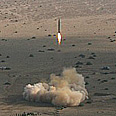
Iranian Shahab test (archives)
צילום: איי אף פי
Report: Iran manufacturing improved missile
Western intelligence source says upgraded Shahab B3 missile in production since 2008. Report says Iran can produce 75 2,000km-range missiles per year, with capability of reaching Israel
Iran has begun the production of the Shahab B3 missile, that has a range of 2,000km (1,242 miles), meaning it is capable of reaching Israel, a western intelligence source reported on Wednesday.
Last month Iran reported a successful experiment of a missile with similar range.
According to the report, production of the improved missile began during 2008. The source claimed that Iran has the ability to manufacture some 75 Shahab B3 rockets per year.
"The Iranians have reached the conclusion that the improved Shahab model meets all the requirements, and have begun the serial production of the missile," said the intelligence source.
"This doesn't meant there won't be further improvements made to the missile," the source added.
The source told the Middle East Newsline agency that Iran tested the new missile for 18 months before the Revolutionary Guards ordered production begin.
The Shahab B3 is armed with a 1-ton warhead and an accuracy range of about 300 meters (984 feet). According to the report, the missile is equipped with advanced navigation systems that are capable of changing the missile's direction even after being launched.
Iran plans to replace the upgraded Shahab with a new and more reliable missile called Sejil, that successfully passed a test launch in November.
Iranian Defense Minister Brigadier General Mostafa Mohammad Najjar said in a television interview at the time that missile was produced by the Iranian aerospace industries.
The minister did not say exactly when the missile was tested, but claimed, "This is a two-stage missile carrying two engines with combined solid fuel."
Reports said the Sejil has a 2,000km range (1,242 miles), and has a form very similar to the Shahab.
Over the summer Iran held a series of missile tests including the improved Shahab 3, Zelzal and Fattah missiles. An examination of pictures published following the events revealed suspicions that the images may have been edited, possibly due to a setback.










